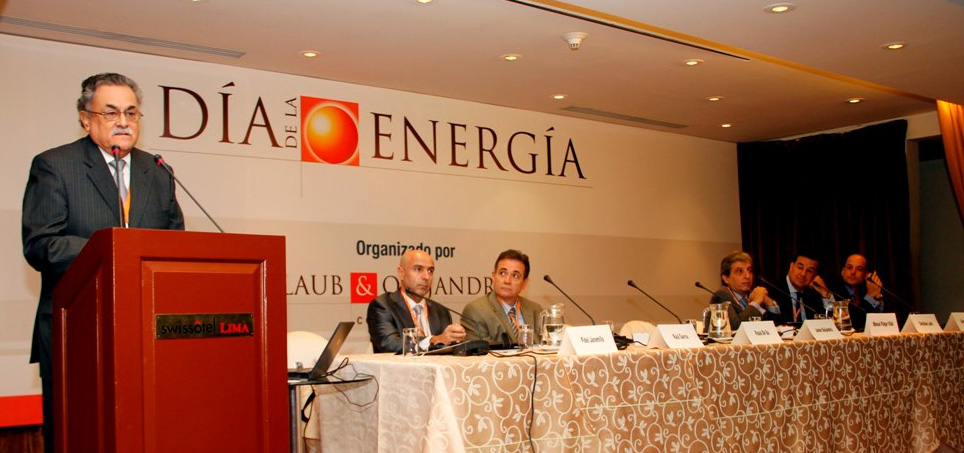Session I: ENERGY POLICY
- 03/07/2012
-
Moderator: Jaime Quijandria
At the opening ceremony of this session, Jaime Quijandría emphasized the importance of diversification of energy sources to guide implementation of long-term appropriate energy policies that allow the country to move towards a sustainable and lower cost matrix, achieving a system of maximum coverage and security, as well as less socio environmental impact.
In this context, Raúl García,, coordinator of the New Sustainable Energy Matrix (NUMES) project, explained the procedure and criteria used for the new matrix proposal and its Strategic Environmental Assessment(See Presentation ). The proposal presented was chosen among 19 different alternatives of energy system configuration and requires estimated investments of $ 83,439 million dollars.
Dr. García emphasized that NUMES is the first strategic planning with long-term integrated approach performed in Peru and takes into account relevant socio environmental implications, the opinion of several parties of the sector (authorities and investors) and civil society, and the adaptation that the regulatory framework (institutional and organizational aspects) of the energy sector must go through to implement the proposed matrix model. NUMES leaves a package of models as planning tools of great value.
Mr. Manuel Pulgar-Vidal emphasized the responsibility of energy sector agents for the effective reduction of socio-environmental impacts (See Presentation). ). He stated that the formulation of public policies in the sector should be based on positive experiences (as in the case of Camisea) and negative experiences (as the problem of communicating benefits of thermoelectric projects in the District of Chilca or the absence of energy saving campaigns), and based on the recognition of complex environmental and social context that our country is now going through.
Mr. Pulgar-Vidal emphasized the importance of the information provided by the State to citizenship regarding projects to be developed. This is why there should be a major concern for transmitting messages appropriately when infrastructure projects must be developed to generate electricity, for example.
On the other hand, Mr. Pulgar-Vidal stated that the environmental indicators of the Strategic Environmental Assessment (SEA) of NUMES project cover key aspects such as emissions of greenhouse gases, destruction of wild system, threats of natural protected areas, natural hazards, affected basins, etc. These indicators should be considered in the execution of energy projects, adding new marine environmental indicators that besides being “unknown” they were not considered in the SEA. To finish his presentation, the Minister of Environment explained the effects and risks that climate change has in the decision-making on energy.
Separately, Christian Laub, , Manager of Investment Banking at Banco de Crédito del Perú (BCP), showed an overview of the situation regarding the most important financing sources to enable the execution of energy projects that are being planned.
Mr. Christian Laub stated that, only in the electricity sub-sector, there are projects that will require financing of over US$ 8’000,000.00, representing an increase of 46% of investments in this sector, for which the capital market would play a very important role. He also explained that, unlike previous years, nowadays, the financing complexity, amounts and terms have been increasing due to the support investors and local banks have in foreign and multilateral banks and due to the financing of AFPs. Finally, he welcomed the implementation of the Mercado Integrado Latinoamericano (MILA) integrating the financial systems of Colombia, Peru and Chile; since it allows Chilean and Colombian banks finance Peruvian projects and vice versa, Peruvian banks finance Chilean and Colombian projects.
Considering the abovementioned, Paul De Sa, , Head of the World Bank’s Sustainable Oil, Gas and Mining Unit, stated that nowadays there is a greater demand of clean energy projects and it is expected that by 2035 the World Bank would support the relative reduction of subsidies and the development of these projects, and that the scenario of 2010, when subsidies intended for the renewable energy projects were only $ 56 million compared to the $ 401 million given for fossil fuels (See Presentation). does not happen again. De Sa also stated that the energy sector challenge was to ensure greater coverage of electricity in a sustainable manner and allowing gradually more than 1,300 million people worldwide who do not have this basic service (especially in rural areas) have access to it.
Finally, Fidel Jaramillo (IDB representative of Peru) and Carlos Heeren (consultant of APOYO),invited panelists, brought out some challenges and questions that remain unresolved. On one hand, Fidel Jaramillo pointed out the need for a planning unit at the State level, which involves observing the weaknesses of the regional governments regarding the roles performed within the energy sector for a greater efficiency in public energy companies.
On the other hand, Mr. Heeren stated that there is still an important concern about the perception of the population regarding energy projects due to a gap between the energy generated and those who receive it. In response, he raised the following questions: How does the energy business implement projects on citizenship? Who will supply the energy? Were the critical success factors identified in energy projects, such as climate change and use of water resources? Among others. Those are tasks that still need to be addressed and considered in an appropriate energy policy
Download Presentations


 Español
Español








